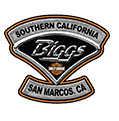Tips for Riding a Harley-Davidson® Trike
 Trikes are a unique group of three-wheeled motorcycles that can offer a number of benefits to their riders, like increased comfort and more storage space (check out more great benefits here!). However, they don’t operate like a two-wheeled motorcycle. They’re designed differently and you’ll need to learn a unique set of skills in order to travel with them safely and efficiently. That’s why Biggs Harley-Davidson has provided some tips to help you get started. You can also contact us at our location in San Marcos, California, with any additional questions you might have. We proudly serve those from San Diego and Oceanside, so let us know how we can assist you!
Trikes are a unique group of three-wheeled motorcycles that can offer a number of benefits to their riders, like increased comfort and more storage space (check out more great benefits here!). However, they don’t operate like a two-wheeled motorcycle. They’re designed differently and you’ll need to learn a unique set of skills in order to travel with them safely and efficiently. That’s why Biggs Harley-Davidson has provided some tips to help you get started. You can also contact us at our location in San Marcos, California, with any additional questions you might have. We proudly serve those from San Diego and Oceanside, so let us know how we can assist you!
Turning on a Trike
If you’ve spent time on a two-wheeled motorcycle, you know turning involves what’s known as counter steering. This refers to the way you lean into a turn in order to get the bike to change directions the way you want it to.
Trikes, on the other hand, are built closer to what you’d expect from a car. You turn by tilting the handlebars to face the direction you want to go, and the wheels follow. There’s no leaning involved. This is known as direct steering.
It might seem intuitive if you’ve spent a lot of time behind the wheel of a car or truck, but there are a few important considerations you need to be keeping in mind. Slow down significantly going into the turn so you can safely navigate through without the risk of tipping over, trying to make the entire turn as smooth as possible.
Also keep in mind that the width of the front part of the trike does not match the width of the rear section. You need to be clearing each turn in a way that accommodates the two back wheels in order to avoid bumping into the curb or another vehicle.
How to Start and Shift
You’ll still get a manual transmission for your trike, and you’ll find there are many similarities. To start the trike, the brake needs to be engaged. To start moving, you’ll want to engage the clutch, shift into first gear, let up on the brakes, and release the clutch as you turn the throttle. Much of the process will probably be familiar to you if you’ve used a manual transmission in a car or other vehicle, but it’ll still take a little practice to get used to it.
Stopping on a Trike
When it comes to stopping, the main thing to remember is that trikes are much heavier than two-wheeled motorcycles. They’re going to take a little bit longer to bring to a complete stop. Try to give yourself as much time as your ride needs to come to a safe stop, and avoid hard braking, as this can lock up the wheels and cause you to lose control.
If you have the option of braking with only the front or back wheels, use the back wheels, where the majority of the weight is. Using the entire trike to come to a stop, meaning front and back wheels, will give you more braking power, but you’ll need to make sure you’re engaging them at the same time.
Get Out and Practice!
While it’s good to gather tips and tricks, the only way you’re going to get better at riding a trike is if you practice. Things are a little strange right now, but you can still relax and enjoy some fresh air by finding a big, empty parking lot, away from people, and testing out how to start, stop, turn, and park your ride.
That way, when shelter-in-place orders are lifted and it’s safe to travel again, you can hit the road with confidence. You can also sign up for special classes with a trained instructor who can teach you to safely ride a trike, including closed-off riding areas to practice.
With a little bit of practice, learning how to ride a trike can be incredibly easy. But you’re also going to need the right Harley-Davidson trike for you, so let us know how we can still get you your very own ride. We proudly serve San Marcos, San Diego, and Oceanside, California, so call us today about our ongoing services!



